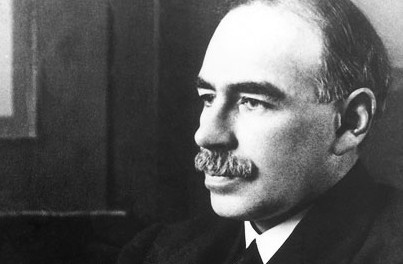Keynes advised the government during the first world war and participated in the Versailles peace conference, which ended up extracting punitive reparations from Germany.
第一次世界大戰期間,凱恩斯曾在出任政府顧問,參與過最終向德國索取懲罰性賠款的凡爾賽和談。
The experience was dispiriting for Keynes, who wrote a number of scathing essays in the 1920s, pointing out the risks of the agreement and of the post-war economic system more generally.
這段經歷令凱恩斯大失所望,促使他在20年代寫了一系列尖銳的文章,從更為宏觀的角度,指出了這些協議以及戰后經濟體系的風險。

Frustrated by his inability to change the minds of those in power, and by a deepening global recession, Keynes set out to write a magnum opus criticising the economic consensus and laying out an alternative.
出于對自己改變當權者思想的無能為力以及日漸加深的全球衰退的受挫感,凱恩斯開始著手撰寫一部批判經濟共識并提出了一種替代共識的巨著。
He positioned the “General Theory” as a revolutionary text—and so it proved.
他對《通論》的定位是一份革命性文件——而且它也證明了自己的確如此。
The book is filled with economic insights.
該書充滿了經濟學的真知灼見。
Yet its most important contribution is the reasoning behind the proposition that when an economy is operating below full employment,
然而,它最重要的貢獻卻是其論點——當經濟體在完全就業之下運行時,
demand rather than supply determines the level of investment and national income.
是需求而非供給決定投資和國民收入水平——背后的推理。
Keynes supposed there was a “multiplier effect” from changes in investment spending.
凱恩斯認為,存在著一種來自投資開支改變的“乘數效應”。
A bit of additional money spent by the government, for instance, would add directly to a nation's output (and income) .
例如,由政府支出的一點額外的錢會直接增加一國的產出(和收入)。
In the first instance, this money would go to contractors, suppliers, civil servants or welfare recipients.
首先,這些錢會流向承包商、供應商、公務員或者福利受益者。
They would in turn spend some of the extra income.
繼而,他們會把這些額外收入中的一部分花出去。
The beneficiaries of that spending would also splash out a bit, adding still more to economic activity, and so on.
這種支出的受益者也會花一部分,令經濟活動在逐步增加,以此類推。
Should the government cut back, the ill effects would multiply in the same way.
如果政府削減開支,不良效應會同樣成倍放大。
Keynes thought this insight was especially important because of what he called “liquidity preference”.
由于他稱之為“流動性偏好”的原因,凱恩斯認為這種真知灼見非常重要。
He reckoned that people like to have some liquid assets on hand if possible, in case of emergency.
他指出,人們喜歡盡可能地在手里有一些流動資產,以備急用。
In times of financial worry, demand for cash or similarly liquid assets rises; investors begin to worry more about the return of capital rather than the return on capital.
金融動蕩時期,對于現金或者類似的流動資產的需要上升;投資者開始更多地為資本的收回而不是收益而擔憂。
Keynes posited that this might lead to a “general glut” : a world in which everyone tries to hold more money, depressing spending, which in turn depresses production and income, leaving people still worse off.
凱恩斯認為,這可能會造成某種“普遍性過剩”:一個人人都想持有更多現錢的世界,它壓制了開支,繼而又壓制了生產和收入,讓人們過得越來越差。
In this world, lowering interest rates to stimulate growth does not help very much.
在這個世界中,降低利率以刺激增長起不到太大的作用。
Nor are rates very sensitive to increases in government borrowing, given the glut of saving.
同時,由于儲蓄過剩,利率對于政府舉債行為的增多也不是特別敏感。
Government spending to boost the economy could therefore generate a big rise in employment for only a negligible increase in interest rates.
因而,以刺激經濟體為目的政府支出,僅僅因為可以忽略不計的利率上升,就可能帶來就業的大幅上升。
Classical economists thought public-works spending would “crowd out” private investment; Keynes saw that during periods of weak demand it might “crowd in” private spending, through the multiplier effect.
古典經濟學家認為,公共項目開支會“擠出”私人投資;凱恩斯則認為,在弱需求期間,它可能透過乘數效應“擠入”私人開支。
Keynes's reasoning was affirmed by the economic impact of increased government expenditure during the second world war.
二戰期間,凱恩斯的推理為增加了的政府開支的經濟影響所證實。
Massive military spending in Britain and America contributed to soaring economic growth.
英美兩國大規模的軍事開支帶來了狂飆突進的經濟增長。
This, combined with the determination to prevent a recurrence of the Depression, prompted policymakers to adopt Keynesian economics, and the multiplier, as the centrepiece of the post-war economic order.
這種增長,加之防止大蕭條卷土重來的決心,一度令決策者將凱恩斯經濟學和財政乘數奉為戰后經濟秩序的核心。
Other economists picked up where Keynes left off.
其他經濟學家沿著凱恩斯的思路走了下去。
Alvin Hansen and Paul Samuelson constructed equations to predict how a rise or fall in spending in one part of the economy would propagate across the whole of it.
阿爾文·漢森和保羅·薩繆爾森構建了一些描述經濟體某一部分支出的漲跌如何擴展至整個經濟體的等式。
Governments took it for granted that managing economic demand was their responsibility.
各國政府想當然地把治理經濟需求當成了他們的責任。
By the 1960s Keynes's intellectual victory seemed complete.
到上世紀60年代,凱恩斯的學術勝利似乎完整了。
In a story in Time magazine, published in 1965, Milton Friedman declared (in a quote often attributed to Richard Nixon) , “We are all Keynesians now.”
在《時代》雜志于1965年發表的一篇文章中,米爾頓·弗里德曼(在經常被當成是尼克松的一句引語中)宣稱:“我們現在都是凱恩斯主義者。”
But the Keynesian consensus fractured in the 1970s.
但是,凱恩斯主義共識在上世紀70年代崩塌了。
Its dominance was eroded by the ideas of Friedman himself, who linked variations in the business cycle to growth (or decline) in the money supply.
它的支配地位逐漸被將商業周期的變化與貨幣供應的漲跌聯系起來的弗里德曼自己的思想所蠶食。
Fancy Keynesian multipliers were not needed to keep an economy on track, he reckoned.
他指出,推崇凱恩斯乘數已經不再為保持經濟正常運轉所必需。
Instead, governments simply needed to pursue a policy of stable money growth.
相反,政府只需要一種穩定的貨幣增長政策。
An even greater challenge came from the emergence of the “rational expectations” school of economics, led by Robert Lucas.
隨著以羅伯特·盧卡斯為首的“理性預期”學派的出現,一種更大的挑戰也隨之而來。
Rational-expectations economists supposed that fiscal policy would be undermined by forward-looking taxpayers.
理性預期學派的經濟學家認為,財政政策會被具有前瞻性的納稅人所瓦解。
They should understand that government borrowing would eventually need to be repaid, and that stimulus today would necessitate higher taxes tomorrow.
這些納稅人應當懂得,政府借的錢終歸需要償還,今天的刺激會使得明天的更高的稅收成為必需。












